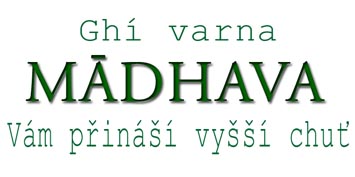Agnihotra ghee
Agnihotra ghí se dá použít jako palivo do ghí lampiček pro osvětlení a dekoraci, na ohňové obřady jako je Agnihotra, knotky na puju atd.
Agnihotra ghí 600g / 720ml - 180 Kč.
Agnihotra ghí 340g / 420ml - 100 Kč.
Jak si udělat knoty pro ghí lampičku
Role of 'Agnihotra' in Prevention of Air Pollution by C.S. PATIL
Agnihotra is performed to achieve equilibrium in nature, enhancement of human life, and to achieve peace of mind. Agnihotra is a basic form of Yajna. It is also stated that the process in the science of bioenergy given by the Vedas, where it is described as a process of fumigation. Agnihotra is defined as the process which purifies the air, through the agency of fire.
Pot of a specific size and shape (pyramidal): Preferably this pot should be of copper. Clay pot can also be used. The most important aspect is the size and shape of the pot. Dimensions of the pot are 14.5 x 14.5 cm at the top, 5.25 x 5.25 cm at the bottom and 6.5 cm in height.
It is because the pyramid powers are very well known for the fact that the shape of the pyramid accumulates electromagnetic waves inside it. The word pyramid itself is explanatory, i.e., (pyro Agni) and (amid * in the centre) which means that a pyramid-shaped pot gives ablazed flame exactly in the centre.
Cowdung cake or dung of the cow family (i.e., cow or bull) is used for preparing the Agnihotra fire. Cow dung is a well known medicine. It contains menthol, ammonia, phenol, indol, formalin and specifically its bacteriophages eradicate the pathogens. Considering all these valuable contents of cow dung, it is known as the best fuel for Agnihotra. Kerosene oil should never be used to produce a flame. Instead, camphor, dry gugul or cotton wicks duly soaked in cow's pure ghee can be used to produce fire.
It is a proven fact that with the mere smell of fresh cow dung, malarial parasites and pathogenic bacteria vanish. Floors or walls of houses coated with cowdung paste are protected from harmful radiations.
Cow ghee: Cow ghee contains approximately Il acids, 12 metals and 2 lactoses, which are very much beneficial. Names of the acids are not yet known. Research work is in progress.
Unbroken rice grain: When rice grains are mixed with cow ghee and burned with cow dung cake the following gases are evolved: (a) ethylene oxide, (b) propylene oxide, (c) formaldehyde, (d) propiolactone and (e) acetylene. Acetylene has maximum amount of heat energy which helps in attracting pollutants from air. Also some more diseases and psychological tensions can be minimized by these gases, which also help in balancing the natural cycle.

